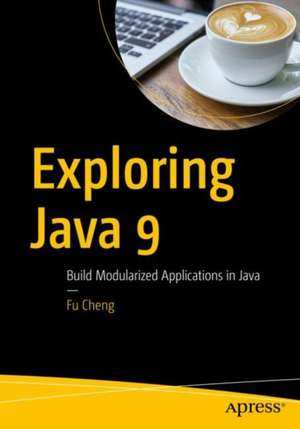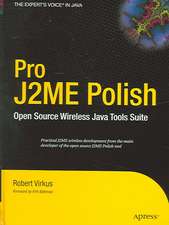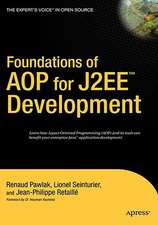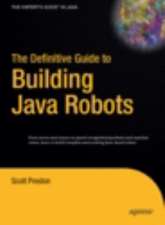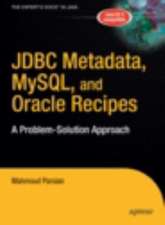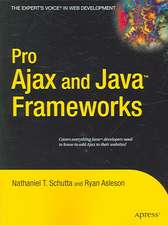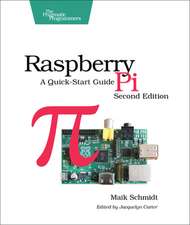Exploring Java 9: Build Modularized Applications in Java
Autor Fu Chengen Limba Engleză Paperback – 2 dec 2017
Discover all the new features and changes in Java 9, including module systems—JPMS or Project Jigsaw. This book covers the whole Java application development life cycle. You'll review all the important concepts, including module descriptor, unnamed module, automatic module, and command line tools.
Exploring Java 9 also serves as a practical guide for migration to module systems. Code samples from real-world scenarios solidify a foundation for learning and development and allow you to apply best practices in actual development.
Additionally, you'll learn about concurrency, ECMAScript 6 features in Nashorn and Parser API, stack-walking API, Stream and Optional, utilities classes, and I/O. And it’s now possible to build modularized applications in Java. You'll see how JPMS affects not only the JDK itself, but also applications that are developed upon it.
What You'll Learn
• Build modularized applications in Java
• Migrate to module systems
• Master enhanced method handles
Who This Book Is For
Java developers with basic development skills
Preț: 134.58 lei
Preț vechi: 168.22 lei
-20% Nou
Puncte Express: 202
Preț estimativ în valută:
25.76€ • 27.99$ • 21.65£
25.76€ • 27.99$ • 21.65£
Carte disponibilă
Livrare economică 31 martie-14 aprilie
Preluare comenzi: 021 569.72.76
Specificații
ISBN-13: 9781484233290
ISBN-10: 1484233298
Pagini: 128
Ilustrații: XV, 174 p. 10 illus., 9 illus. in color.
Dimensiuni: 178 x 254 x 18 mm
Greutate: 0.34 kg
Ediția:1st ed.
Editura: Apress
Colecția Apress
Locul publicării:Berkeley, CA, United States
ISBN-10: 1484233298
Pagini: 128
Ilustrații: XV, 174 p. 10 illus., 9 illus. in color.
Dimensiuni: 178 x 254 x 18 mm
Greutate: 0.34 kg
Ediția:1st ed.
Editura: Apress
Colecția Apress
Locul publicării:Berkeley, CA, United States
Cuprins
Chapter 1: Introduction.- Chapter 2: Module System.- Chapter 3: jshell.- Chapter 4: Collections, Streams, and Optional.- Chapter 5: Process API.- Chapter 6: Platform logging API and service.- Chapter 7: Reactive streams.- Chapter 8: Variable handles.- Chapter 9: Enhanced method handles.- Chapter 10: Concurrency.- Chapter 11: Nashorn.- Chapter 12: I/O.- Chapter 13: Security.- Chapter 14: User interface.- Chapter 15: JVM.- Chapter 16: Miscellaneous.
Notă biografică
Fu Cheng is a software developer living in Auckland, New Zealand with rich experience in applying best practices in real product development and strong problem solving skills.
He is the author of Build Mobile Apps with Ionic 2 and Firebase by Apress and Understanding Java 7: The Core Techniques and Best Practices (Simplified Chinese edition), which covers the new features of Java SE 7 and provides a deep dive of Java platform core features, including JVM internals, byte code manipulation, class loader, generics, security, concurrent programming and serialization.
He is also a regular writer on the IBM developerWorks China and InfoQ China website with more than 50 published technical articles covering various technical topics.
Textul de pe ultima copertă
Discover all the new features and changes in Java 9, including module systems—JPMS or Project Jigsaw. This book covers the whole Java application development life cycle. You'll review all the important concepts, including module descriptor, unnamed module, automatic module, and command line tools.
Exploring Java 9 also serves as a practical guide for migration to module systems. Code samples from real-world scenarios solidify a foundation for learning and development and allow you to apply best practices in actual development.
Additionally, you'll learn about concurrency, ECMAScript 6 features in Nashorn and Parser API, stack-walking API, Stream and Optional, utilities classes, and I/O. And it’s now possible to build modularized applications in Java. You'll see how JPMS affects not only the JDK itself, but also applications that are developed upon it.
Caracteristici
Complete guide to Java platform module system (Project Jigsaw) Covers all new features and changes in Java 9 Real-world examples and usage scenarios
